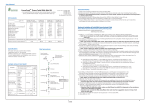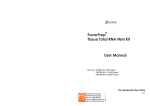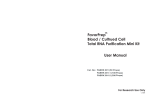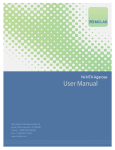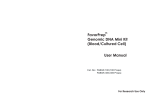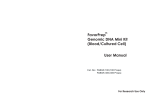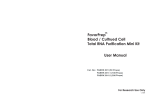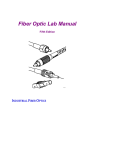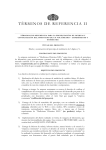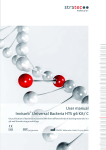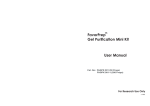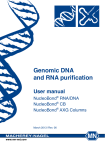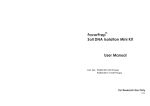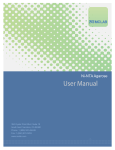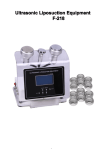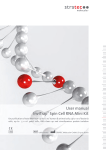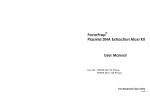Download FavorPrep Blood/ Cultured Cell Total RNA Mini Kit
Transcript
User Manual Important Notes: TM FavorPrep Blood/ Cultured Cell Total RNA Mini Kit -- For isolation RNA from human whole blood, animal cells, animal tissues, bacteria, yeast, paraffin fixed sample, fungi and for RNA clean-up Cat. No.: FABRK 000 FABRK 001 FABRK 001-1 FABRK 001-2 For Research Use Only Kit Contents: Cat. No: FABRK 000-Mini (4 preps_sample) RL Buffer FARB Buffer Wash Buffer 1 a Wash Buffer 2 (concentrate) RNase-free Water Filter Column FARB Mini Column Collection Tube Elution Tube User Manual 15 ml 3 ml 3 ml 1.5 ml 0.5 ml 4 pcs 4 pcs 8 pcs 4 pcs 1 FABRK 001 (50 preps) 120 ml 25 ml 30 ml 15 ml 6 ml 50 pcs 50 pcs 100 pcs 50 pcs 1 FABRK 001-1 (100 preps) FABRK 001-2 (300 preps) 240 ml 45 ml 60 ml 35 ml 6 ml 100 pcs 100 pcs 200 pcs 100 pcs 1 240 ml x 3 130 ml 170 ml 50 ml x 2 8 ml x 2 300 pcs 300 pcs 600 pcs 300 pcs 1 140 ml 200 ml Protocol: Isolation of Total RNA from Human Whole Blood Please Read Important Notes Before Starting Following Steps. Additional requirment: ß-Mercaptoethanol and 70% RNase-free ethanol 1. Red blood cells lysis 1-1. Add 200 ~ 300 μl of anticoagulant-preserved fresh human whole blood to a microcentrifuge tube (1.5 ml or 2.0 ml tube) (not provided). If the sample volume is more than 200 ul, use a 2.0 ml tube as the sample container. -- Note! Do not overload, too much sample will make cell lysis incompletely and lead to lower RNA yield and purity. 1-2. Mix 5 volume of RL Buffer with 1 volume of the sample and mix well by inversion. 1-3. Incubate on ice for 10 min. Vortex briefly 2 times during incubation. 1-4. Centrifuge for 1 min at 4,500 rpm to form a cell pellet and discard the supernatant completely. 1-5. Add 600 μl of RL Buffer to resuspend the cell pellet by briefly vortexing. 1-6. Centrifuge for 1min at 4,500 rpm to form a cell pellet again and discard the supernatant completely. Preparation of Wash Buffer 2 by adding ethanol (96 ~ 100%) Ethanol volume for Wash Buffer 2 a 6 ml 60 ml Specification: Principle: mini spin column (silica matrix) Operation time: 30 ~ 60 minutes Binding capacity: up to 100 µg total RNA/ column Column applicability: centrifugation and vaccum Minimum elution volume: 40 µl Sample amount and yield Sample Recommended amount of sample used Human whole blood (up to 300 µl ) 300 µl 10 mg 25 10 10 30 50 35 15 45 1 x 10 cells 9 60 40 Yeast S. cerevisiae 1 x 10 7 cells 7 (up to 5 x 10 ) 25 Animal Tissue (Mouse/rat) (up to 30 mg) Embryo Heart Brain Kidney Liver Spleen Lung Thymus Bacteria E. coli B. subtilis Cultured cells Concentration & Resuspension 7a. Add 250 µl of Wash Buffer 1 to the FARB Mini Column, centrifuge at full speed for 1 min. Discard the flow-through and return the FARB Mini Column back to the Collection Tube. 7b. Add 60 µl of RNase-free DNase 1 solution (0.5U/ul, not provided) to the membrane center of the FARB Mini Column. Place the column on the benchtop for 15 min. 7c. Add 250 µl of Wash Buffer 1 to the FARB Mini Column, centrifuge at ful speed for 1 min. Discard the flow-through and return the FARB Mini Column back to the Collection Tube. 7d. After DNase 1 treatment, proceed to step 9. Lysis (FARB Buffer) 1 6 Animal cells 6 (up to 5 x 10 ) Whole Blood Yield (µg) 10 15 30 12 NIH/3T3 HeLa COS-7 LMH 2. Add 350 µl of FARB Buffer and 3.5 µl of ß-Mercaptoethanol to the cell pellet. Vortex vigorously for 1 min to resuspend the cells completely. -- Note: If the clump is still visible after vortex, pipet sample mixture up and down to break down the clump. 3. Place a Filter Column to a Collection Tube and transfer the sample mixture to the Filter Column. Centrifuge at full speed (~ 18,000 x g) for 2 min. 4. Transfer the clarified supernatant from the Collection Tube to a new microcentrifuge tube (not provided), and measure the volume of the supernatant. -- Note: Avoid to pipet any debris and pellet when transfering the supernatant. 5. Add 1 volume of 70 % RNase-free ethanol and mix well by vortexing. 6. Place a FARB Mini Column to a Collection Tube and transfer the ethanol added sample mixture (including any precipitate) to the FARB Mini Column. Centrifuge at full speed for 1 min, discard the flow-through and return the FARB Mini Column back to the Collection Tube. 7. Optional step: DNase I digestion To eliminate genomic DNA contamination, follow the steps from 7a. Otherwise, proceed to step 8 directly. Brief procedure: Red blood cell lysis (RL Buffer) 1 x 10 cells centrifuge Filtration Add 70% ethanol centrifuge centrifuge centrifuge 1. Make sure everything is RNase-free when handling RNA. 2. Buffers provided in this system contain irritants. Wear gloves and lab coat when handling these buffers. 3. Caution: ß-mercaptoethanol (ß-Me) is hazardous to human health. perform the procedures involving ß-Me in a chemical fume hood. 4. Add required volume of RNase-free ethanol (96~100%) to Wash Buffer 2 when first use. 5. All centrifuge steps are done at full speed (~18,000 x g) in a microcentrifuge. 6. Prepare RNase-free DNase 1 reaction buffer (1M NaCl, 10 mM MnCl2, 20 mM Tris-HCl, pH 7.0 at 25ºC) and make the final concentration of DNase I to 0.5 U/μl. 8. Add 500 µl of Wash Buffer 1 to the FARB Mini Column, centrifugeat at full speed for 1 min. Discard the flow-through and return the FARB Mini Column back to the Collection Tube. 9. Add 750 µl of Wash Buffer 2 to the FARB Mini Column, centrifuge at full speed for 1 min. Discard the flow-through and return the FARB Mini Column back to the Collection Tube. -- Note: Make sure that ethanol has been added into Wash Buffer 2 when first use. 10. Repeat step 9 for one more washing. 11. Centrifuge the FARB Mini Column at full speed for an additional 3 min to dry the FARB Mini Column. -- Important Step! This step will avoid the residual liquid to inhibit subsequent enzymatic reaction. 12. Place the FARB Mini Column to a Elution Tube (provided, 1.5 ml microcentrifuge tube). 13. Add 40 ~ 100 µl of RNase-free ddH2O to the membrane center of the FARB Mini Column. Stand the FARB Mini Column for 1 min. -- Important Step! For effective elution, make sure that RNase-free ddH2O is dispensed on the membrane center and is absorbed completely. -- Important : Do not elute the RNA using RNase-free water less than suggested volume (< 40 µl). It will lower the RNA yield. 14. Centrifuge the FARB Mini Column at full speed for 1 min to elute RNA. 15. Store RNA at -70C. RNA Binding (FARB Mini Column) optional step: DNase I digestion Washing (Wash Buffer 1) (Wash Buffer 2 x 2) RNA Elution (RNase-free water) 1 v 0515 2 Protocol: Isolation of Total RNA from Animal Cells Protocol: Isolation of Total RNA from Yeast Additional requirment: ß-Mercaptoethanol 70% RNase-free ethanol Additional requirment: ß-Mercaptoethanol 70% RNase-free ethanol Enzymatic disruption: Lyticase or zymolase Sorbitol buffer (1 M sorbitol; 100 mM EDTA; 0.1% ß-ME ) 30 °C water bath or heating block Mechanical disruption: 2 ml screw centrifuge tube Acid-washed glass beads, 500 ~ 700 µm Please Read Important Notes Before Starting Following Steps. Please Read Important Notes Before Starting Following Steps. 6 1. Collect 1 ~ 5 ×10 cells by centrifuge at 300 x g for 5 min at 4 °C. Remove all the supernatant. -- Note! Do not overload, too much sample will make cell lysis incompletely and lead to lower RNA yield and purity. 2. Add 350 µl of FARB Buffer and 3.5 µl of ß-Mercaptoethanol to the cell pellet. Vortex vigorously for 1 min to resuspend the cells completely. -- Note: If the clump is still visible after vortex, pipet sample mixture up and down to break down the clump. 3. Follow Human Whole Blood Protocol starting from step 3. 7 1. Collect up to 5 x 10 of yeast culture by centrifuge at 5,000 x g for 10 min at 4 °C. Remove all the supernatant. 2A. Enzymtic disruption: 2A-1: Resuspend the cell pellet in 600 µl sorbitol buffer (1 M sorbitol; 100 mM EDTA; 0.1% ß-ME) (not provided). Add 200 U zymolase or lyticase and incubate at 30 °C for 30 min. --Note! Prepare sorbitol buffer just before use. 2A-2. Centrifuge at 300 x g for 5 min to pellte the spheroplasts. Remove all the supernatant. 2A-3. Add 350 µl of FARB Buffer and 3.5 µl of ß-Mercaptoethanol to the pellet. Vortex vigorously to disrupt the spheroplasts for 1 min. Incbuate sample mixture at room temperature for 5 min. Protocol: Isolation of Total RNA from Animal Tissues Please Read Important Notes Before Starting Following Steps. Additional equipment: liquid nitrogen & mortar a rotor-stator homogenizer or a 20-G needle syringe ß-Mercaptoethanol 70% RNase-free ethanol 1 Weight up to 30 mg of tissue sample. Grind the sample in liquid nitrogen to a fine powder with a mortar and transfer the powder to a new microcentrifuge tube (not provided). -- Note! Avoid thawing the sample during weighing and grinding. 2. Add 350 µl of FARB Buffer and 3.5 µl of ß-Mercaptoethanol. Homogenize the sample by using a rotor-stator homogenizer or by passing the sample lysate through a 20-G needle syringe 10 times. Incubate at room temperature for 5 min. -- Important step: In order to release more RNA from the harder samples, it is recommended to homogenize the sample by using suitable homogenize equipment, for example, with a rotot-stator homogenizer. 3. Follow Human Whole Blood Protocol starting from step 3. Protocol: Isolation of Total RNA from Bacteria Please Read Important Notes Before Starting Following Steps. Additional requirment: ß-Mercaptoethanol 70% RNase-free ethanol 30 °C water bath or heating block 2 ml screw centrifuge tube Lysozyme reaction solution: (10mg/ ml lysozyme; 20mM Tris-HCl, pH 8.0; 2mM EDTA; 1.2% Trition) Acid-washed glass beads, 500 ~ 700 µm 9 1. Transfer up to 1x10 cells well-grown bacterial culture to a 2 ml screw centrifuge tube. -- Note! Make sure the amount of total RNA harvested from sample do not excess the column’s binding capacity (100 µg) when estimate the sample size. Too much sample will make cell lysis incompletely and lead to lower RNA yield and purity. If RNA amount is hard to determin on 8 some species, using ≤ 5 x 10 cells as the starting sample size. 2. Descend the bacterial cells by centrifuge at full speed (~18,000 x g) for 2 min at 4 °C. Remove all the supernatant. 3. Add 100 µl of lysozyme reaction solution. Pipet up and down to resuspend the cell pellet and incubate at 37°C for 10 min. 4. Add 350 µl of FARB Buffer and 3.5 µl of ß-Mercaptoethanol. 5. Add 250 mg of acid-washed glass beads (500 ~ 700 nm) and vortex vigorously for 5 min to disrupt the cells. 6. Centrifuge at full speed (~18,000 x g) for 2 min to spin down insoluble material. Transfer the supernatant to a microcentrifge tube (not provided) and measure the volume of the clear lysate. -- Note! Avoid pipetting any debris and pellet in the Collection Tube. 7. Follow human Whole Blood Protocol starting from step 5. 3 2B. Mechanical disruption: 2B-1. Add 350 µl of FARB Buffer and 3.5 µl of ß-Mercaptoethanol to the pellet and vortex vigorously to resuspend the cells completely. 2B-2. Transfer the sample mixture to a 2 ml screw centrifuge tube and add 250 mg of acid-washed glass beads (500 ~ 700 nm) and vortex vigorously for 15 min to disrupt the cells. 3. Follow Human Whole Blood Protocol starting from step 5. Protocol: Isolation of Total RNA from Paraffin-embedded tissue Please Read Important Notes Before Starting Following Steps. Additional equipment: xylene & ethanol (96~100%) liquid nitrogen & mortar a rotor-stator homogenizer or a 20-G needle syringe ß-Mercaptoethanol 70% RNase-free ethanol 1. Transfer up to 15 mg paraffin-embedded tissue sample to a microcentrifuge tube (not provided). -- Remove the extra paraffin to minimize the size of the sample slice. 2. Add 0.5 ml xylene, mix well and incubate at room temperature for 10 min. 3. Centrifuge at full speed for 3 min. Remove the supernatant by pipetting. 4. Add 0.25 ml xylene, mix well and incubate at room temperature for 3 min. 5. Centrifuge at full speed for 3 min. Remove the supernatant by pipetting. 6. Repeat step 4 and step 5 7. Add 0.3 ml ethanol (96- 100 %) to the deparaffined tissue, mix gently by vortexing. Incubate at room temperature for 3 min. 8. Centrifuge at full speed for 3 min. Remove the supernatant by pipetting. 9. Repeat step 7 and step 8. 10. Follow Animal tissue Protocol starting from step 1 for sample disruption then follow Human Whole Blood protocol starting from step 3. Protocol: RNA Clean-Up Please Read Important Notes Before Starting Following Steps. Additional equipment: xylene & ethanol (96~100%) 1. Trandfer 100 µl of RNA sample to a microcentrifuge tube (not provided). -- If the RNA sample is less than 100 µl, add RNase-free water to make the sample volume to 100 µl. 2. Add 300 µl of FARB Buffer and 300 µl of RNase-free ethanol ( 96~100 %) and mix well by vortexing. 3. Place a FARB Mini Column to a Collection Tube and transfer the ethanol added sample mixture to the FARB Mini Column. Centrifuge at full speed for 1 min and discard the flow-through and return the FARB Mini Column back to the Collection Tube. 4. Follow Human Whole Blood Protocol starting from step 8. 4


